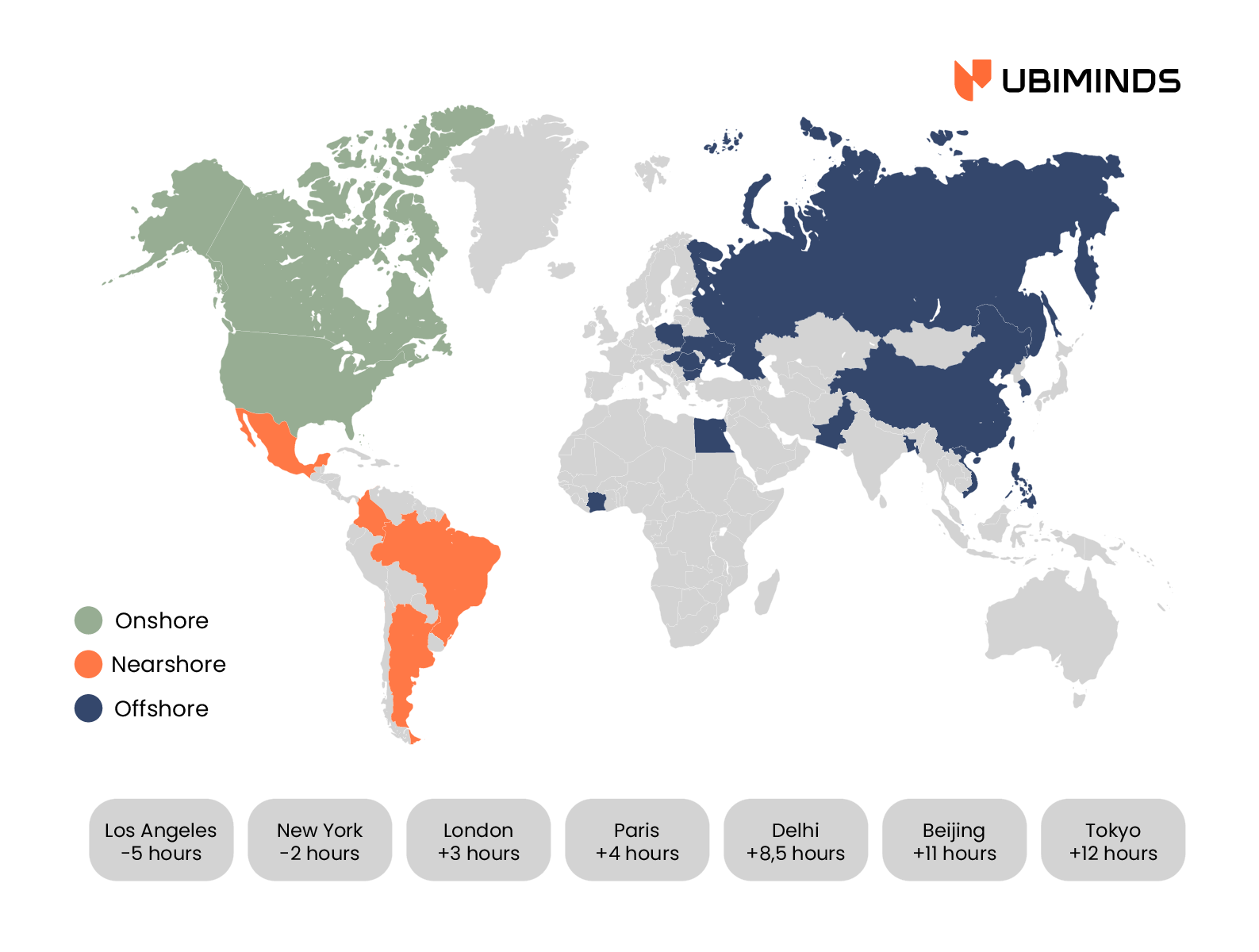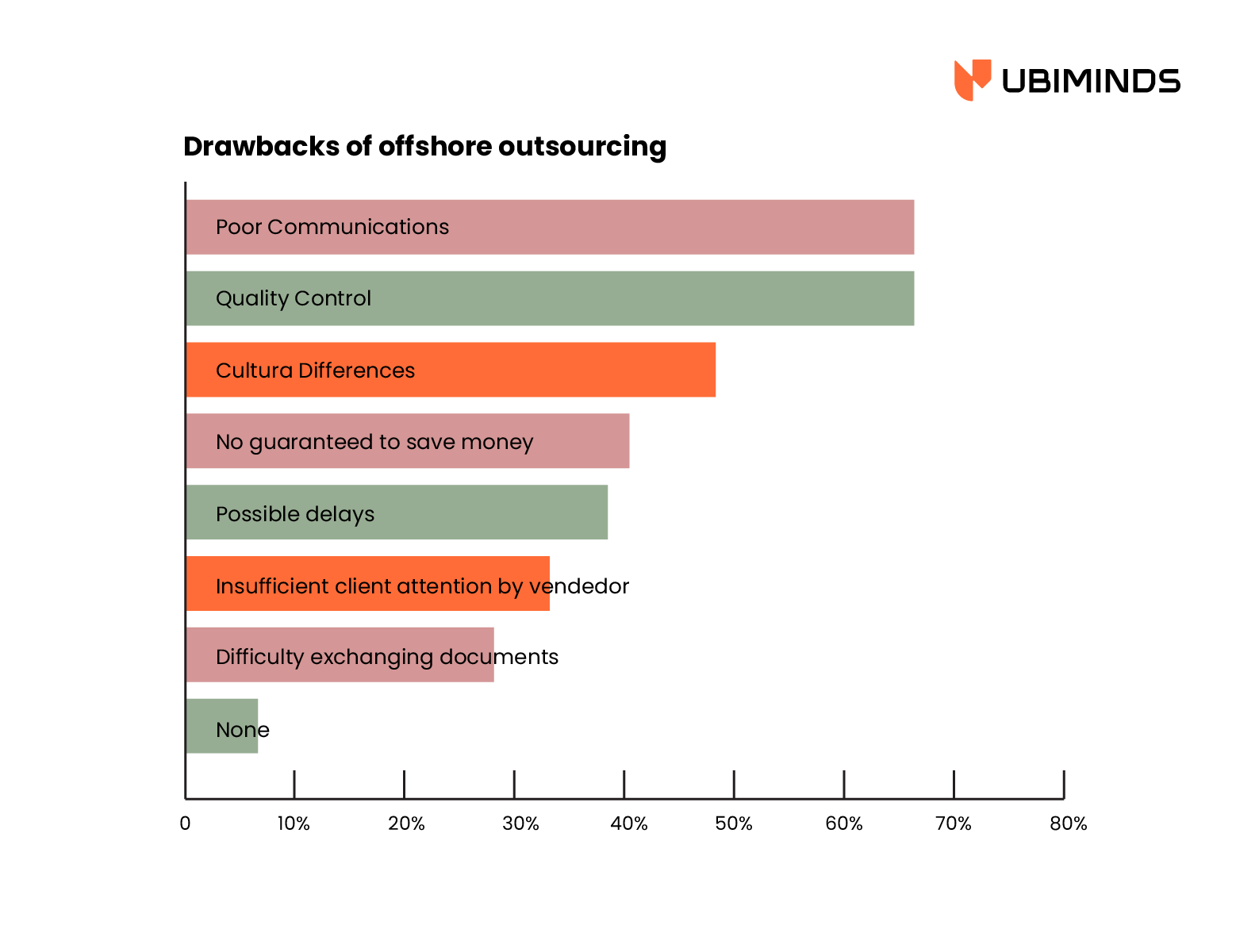In other times, in-house teams were vital for software businesses. But not anymore. Modern companies increasingly leverage nearshore software development services, particularly in locations with geographical proximity. Many opt to delegate projects to nearshore outsourcing firms. Outsourcing helps them save costs, and time, and stay productive. After all, nearshore outsourcing offers numerous advantages. This involves delegating software development services or specific tasks to companies located in nearby countries.
Scaling your IT team without losing efficiency and productivity during the hiring process is a hard challenge to equalize. Considering the high demand for high skilled developers in the USA, and the recruitment process involved, it’s almost impossible to hire great talents at affordable prices.
For instance, software engineers in New York City can command an average salary of USD 150k, plus a fringe of about 20%. This translates to a minimum cost of USD 180k for hiring a local engineer. Moreover, traditional recruitment processes carried out by an in-house HR team can extend over several months.
One solution to this dilemma involves expanding the talent pool beyond US borders. Here’s what you need to know.
The Risks of Unreliable Nearshoring Vendors
However, depending on unreliable third-party providers can introduce various challenges, such as need for additional layers of remote worker management and software team collaboration hurdles. You’ll have limited control over processes and get in trouble with time zone differences, and linguistic and cultural barriers can make matters worse.
This can elevate the risk profile in various aspects, such as losses in software solution quality, compromising legal protection regarding Intellectual Property, and reduced software team performance. and other risks that you can check in detail in this article.
Would this be a dead end? Absolutely not.
When done right, nearshore software development is highly advantageous, providing access to world-class software experts located in similar time zones, making all the processes faster, less costly, and yielding great results.
How does it work? What are the Pros and Cons? Continue reading to explore further about nearshore software outsourcing and its advantages!
Additional Questions, Answered.
IT outsourcing as an industry is experiencing healthy growth and is predicted to grow by 4.42% between 2018 and 2022. At the same time, nearshore software development services mean counting on the cost-benefit of having a dedicated, distributed team abroad, while still being able to manage them as if they were in-house teams. The great secret is that nearshoring software development teams can be smartly managed thanks to cultural similarities and geographical proximity, ensuring high level quality and efficiency in managing your team. Many American companies are adopting this model – nearshore business process outsourcing already reached a revenue of 23.6$ billion, according to Statista. Given that the expectation with outsourcing is to save time and increase productivity, dealing with poor communication or lowering the quality when developing your products must be out of the question! With this in mind, many companies have embraced nearshore software teams, because it allows leaders to tap into a global talent pool without the high expenses associated with hiring within the US. US organizations already registered an average of 38% to 48% savings in labor costs by outsourcing IT functions to Central and South America. Here are some benefits of selecting nearshore software engineers for your team: The home office is a divine gift for IT teams (thesis more than confirmed after the covid-19 pandemic). But let’s be honest: sometimes nothing can replace being face-to-face with your team, right? When considering a nearshore team, you’ll gain advantages such as: Nearshoring software development allows you to meet with your team in a time zone similar to yours. As a positive result of this proximity of locations you can: Eliminating time offsets altogether would undoubtedly simplify matters. It’s impossible to avoid them entirely, but many issues can be solved by Nearshore Teams. As a nearshore software development team with aligned schedules and language proficiency, the efficiency of the integration with the in-house software development team is much easier. With proper integration, internal and outsourced teams can complement each other effectively, leveraging the strengths of each model. You more than anyone know that a full and well-done integration is only accomplished after a series of conversations, technical meetings, and frequent get-togethers. Therefore, establishing strong relationships and routines is easier with a nearshore team compared to offshore arrangements. Engaging developers from similar cultures ensures effective communication. It can be easier to talk to someone familiar with American culture. Research in open-source software communities reveals a tendency for developers to connect with peers of similar performance and experience levels. Thus, establishing cultural similarity is crucial for integrating internal and nearshore developers. Nearshore software development is composed of high skilled engineers and devs who will be able to add value where in-house teams struggle. Many South American countries demonstrate high proficiency in English, surpassing nearshore software outsourcing destinations like China and India. Brazilian devs, for instance, are excellent programmers to assist tech companies overseas through companies offering staff augmentation in LatAm. Brazil’s software market has grown steadily for over a decade, surpassing China, and ranking the country seventh globally in the industry. The country boasts over 250k IT professionals, and approximately 23k new IT graduates entering the industry each year, Brazil is a great place to find and hire software engineers. Onshore, Nearshore e Offshore Original reference: Analysis of Brazil as an Offshore Services Location, Gartner, 2019 Software Development Teams should feel that they can easily communicate with their team members as well as upper management, otherwise, nothing will work as it should. With nearshoring software development, the communication style and quality expectations are comparable to onshoring but at rates similar to offshoring. To enhance communication between outer and internal resources, you should: One of the best benefits of Nearshore Teams is hiring excellent software engineers and devs cheaper than US developers. Cost-per-hire can be reduced by 40-50%. There’s an entire hidden pool of highly qualified and innovative Engineers overseas still waiting to be explored. For instance, Brazil boasts the largest Startup Ecosystem in Latin America. The largest city in the continent, São Paulo, attracts numerous new and established companies – such as Google and Facebook. Other cities like Rio, Belo Horizonte, and Florianópolis are also leading Latam’s tech scene and luring the most talented engineers in the continent to work for their tech companies. Engineers with strong educational backgrounds, multilingual skills, and ambitious career goals. See more about the Brazilian IT Market: Nearshore and Offshore could be a worry in some companies when thinking about how people from different cultures can work together, just as a language barrier. Having a third party to find the right people for you can be a fast and cheaper way. One of the greatest advantages of nearshoring personnel is that the company can also delegate to a third party what kind of people they are looking for. In a broad spectrum, the IT industry needs people who can work with data, machine learning, and microservices. C-levels say many engineers lack empathy and communication skills, and that companies need people who can explain to non-technical people why something is important. Engineers who show a better understanding of business value and good soft skills are more likely not only to get hired but also to integrate better with the whole team. Leaving the tech knowledge aside, engineers stand out if they: – Have listening skills (participate passively to actually learn and process); – Are solutions thinking (focus on getting things done instead of competing over merit); – Have abstraction skills (pattern-match in an open-ended discussion even if the end result isn’t clear yet). Since the Brazilian IT market is large, the chances of finding people aligned with your company’s values and that go beyond stereotypes, surpassing the basic requirements, are much higher. Find more about Brazil’s great tech talent pool, read about staff augmentation: how to hire software developers in Brazil in 5 easy steps, and check why you should hire Brazilian Software Engineers. Nearshore, offshore, onshore… At last, what’s the difference between them? Let’s begin with the traditional: onshore. This model refers to giving work to an organization in the same country you reside in. One of the best benefits of working with an onshore team is to collaborate with your team daily and of course Real-time communication. But, costs usually are higher. In the meantime, offshore outsourcing relocates work to different countries – mostly like India, China, and Eastern Europe. That’s why chances are that your offshore company follows business and management processes differently from your own. Time zone differences, linguistics (documentation standards, nomenclature, level of detail, etc.), and culture usually are the biggest barriers. Drawbacks of offshoring include poor communications, quality control, and cultural differences Finally, nearshore outsourcing means contracting teams in a nation that is geographically (and relatively) near to the hiring company’s home country. Besides that, working with nearshore devs means gaining a diversity of skill sets, practices, protocols, and Gai, having a fresh point of view on the problem, and establishing more autonomy to create innovative products. Also, whether with offshore or nearshore you can have a bigger and more complex project being developed at the same time by different teams working remotely. Nearshore benefits grow over time Original source: Softtek Understanding these three models will be crucial to establishing your strategy of building and scaling high-performance teams. If you want to avoid that your saving money hiring strategy turns into a nightmare, your outsourcing must be well thought out. Consider that outsourced engineers aren’t in full synergy with your product team, so to accomplish your goal of building a high-performed software development team you should create successful communication, effective validation mechanisms, and processes to avoid re-work to fix or adapt non-conforming code. From the first interview until the integration and day-by-day work, it’s very important to align all the expectations, methodologies, and deadlines. Outsource or not? That’s the question. It’s good to say: outsourcing doesn’t do miracles at the same time as owning your own team doesn’t necessarily mean that you have everything perfectly controlled. This is a common pitfall that many IT Leaders fall into. Before deciding for or against staff augmentation, consider the company goal. If your company needs to acquire talents for the long term, but also reduce costs, outsourcing will be the best choice. If time and money are not a problem for hiring software engineers, then building a fully in-house team is possible. Here are some questions that can help you: Anyway, the IT leader’s purpose must be to find the best cost-benefit and this objective leads most managers to choose to outsource, as shown by this survey by Deloitte. Primary reasons organizations choose IT outsourcing: Top 5 reasons for opting for an In-house development team: A fully in-house engineer is certainly the dream of all Software Development Teams. If you need to gather a high-performance team based on our own culture and methodology and, of course, money and time are not a problem for you, you can go ahead. In contrast to the in-house model, outsourcing your Software Development Process is a viable solution if: To quickly solve this question, compare below: At times, a blend of in-house engineers, staff augmentation, and project outsourcing proves optimal. The truth is that there is no 100% answer for it. Anyway, cost-benefit and quality will always be the deciding factor at the forefront. When possessing a strong in-house development team, yet requiring a specialist with specific skills, you should consider integrating an overseas talent with the rest of your engineers. Or, if you need to expand the operation in terms of intelligence (but haven’t increased your budget), nearshore combined with in-house also will be perfect for you. It’s now common to have a half in-house, half outsourced approach which can yield valuable knowledge sharing. Make sure that you treat them the same when work is in question, Encourage Communication, and Track the Results in remote teams. I’m sure that will be an interesting experience. — When deciding where to find your IT outsourcing provider, it’s important to know the exact requirements of your project, the allocated budget, and the time frame allotted for completion. Some Ubiminds’ talent-as-a-service clients argue that technical training is something the company can provide, but soft skills are valuable and not always easy to find. Different cultures can also be an advantage in software team collaboration. High-quality engineers and full teams can be found abroad and the company doesn’t even need to relocate personnel. If you’re considering working with high-performance nearshore development teams, talk to Ubiminds to find out more about our strategy to bring the best result to your company! Learn what Ubiminds do and how much it costs to hire software developers in Brazil. Considering high-performance nearshore development teams? Contact Ubiminds to learn more about our strategies for optimal outcomes. International Marketing Leader, specialized in tech. Proud to have built marketing and business generation structures for some of the fastest-growing SaaS companies on both sides of the Atlantic (UK, DACH, Iberia, LatAm, and NorthAm). Big fan of motherhood, world music, marketing, and backpacking. A little bit nerdy too!Unlocking the Undeniable Benefits of Nearshore Software Development
Reasons why Short Flight Times are Important
Reasons Why Compatible Time Zones Can Make Your Software Development Strategy Easier
How Easy is Integration with the In-House Development Crew
How You Can Gain A Higher Level of Engagement By Bringing Together Related Cultures

How you can Enhance Communication Between Outer and Internal Resources
Value-for-money: When Cheaper Price than US Developers is an Alternative
Where to Find the Right People to Nearshore your Development Team
Still, Confused? Learn What is The Difference Between Inshore vs Nearshore vs Offshore


The Difference Between Onshore, Nearshore, and Offshore (Table Comparison)
Onshore
Nearshore
Offshore
0 hours of difference
1 to 3 hours difference
6 to 12 hours of difference
The software development team is in the same country as your company
The software development team is in a nearby country
The software development team is usually on a different continent
It’s expensive and time-consuming
It´s cost-effective when compared with your local market
Often cheaper than the nearshore option
Not applied
Direct flights available (with a flight duration of 2 to 3 hours)
Long flights (with a flight duration of 13-20 hours)
Not applied
$ 450 average (airfare)
$ 2,000 minimum (airfare)
Can have the same difficulty of nearshoring management
Easier to manage due to the short time zone difference
More difficult to manage due to the time zone difference
X factor: What is The Difference Between Own Team vs Outsourced
How to Avoid Rifts Between your American-based Team and Whoever is Abroad
The Dilemma that Every CTO Needs to Face: Own Team vs Outsourced
When to Opt for Fully In-House Engineers
When Should You Go for Fully Outsourced Engineers?
Topic
Nearshore Team
US Developer (onshore)
When costs are equal
Winner
Long Term Commitment
Equal
Equal
No Office Distractions
Winner
Quality of code
Most of the time, the winner
When Should You Mix in-house Engineers, Staff augmentation, and Project Outsourcing?
We Assist in Custom Curating Your Product Engineering Team with Nearshore Talent Tailored to Your Needs.






